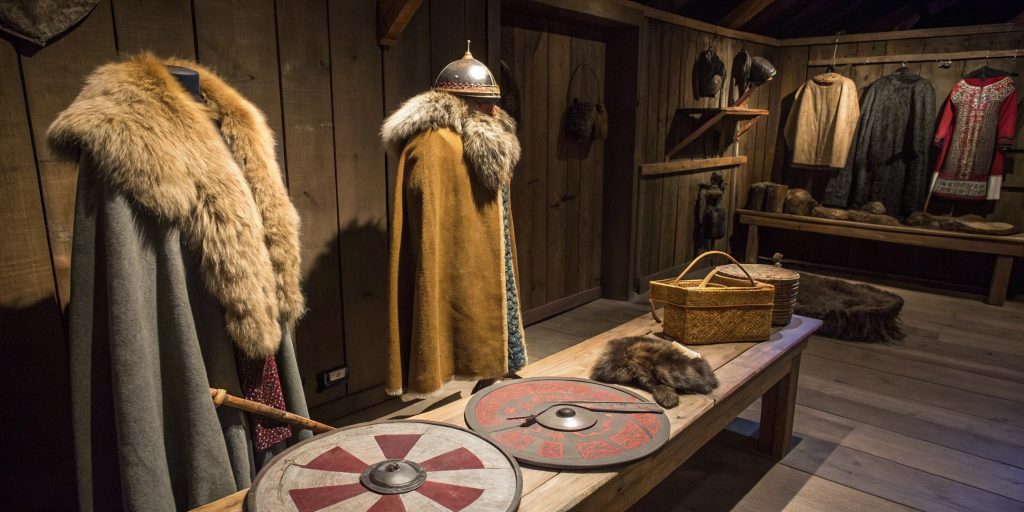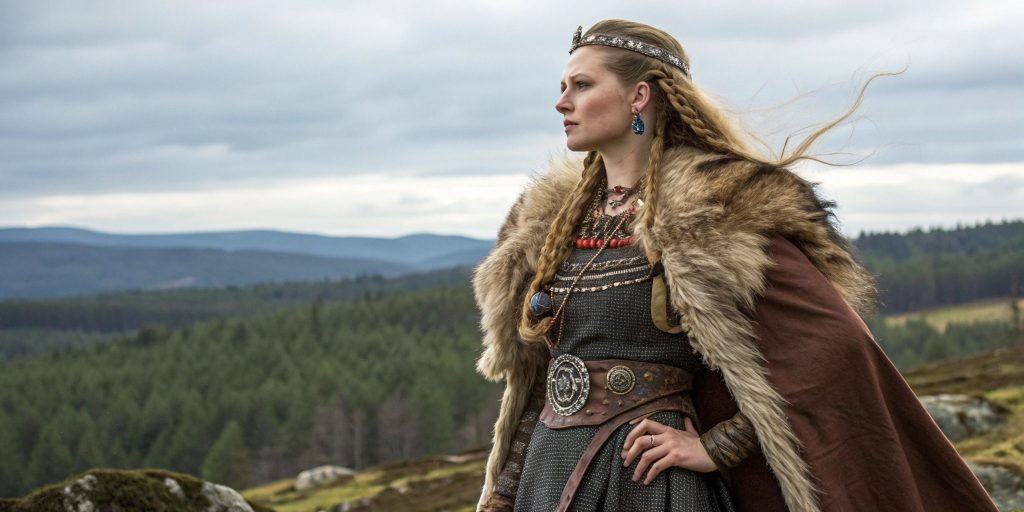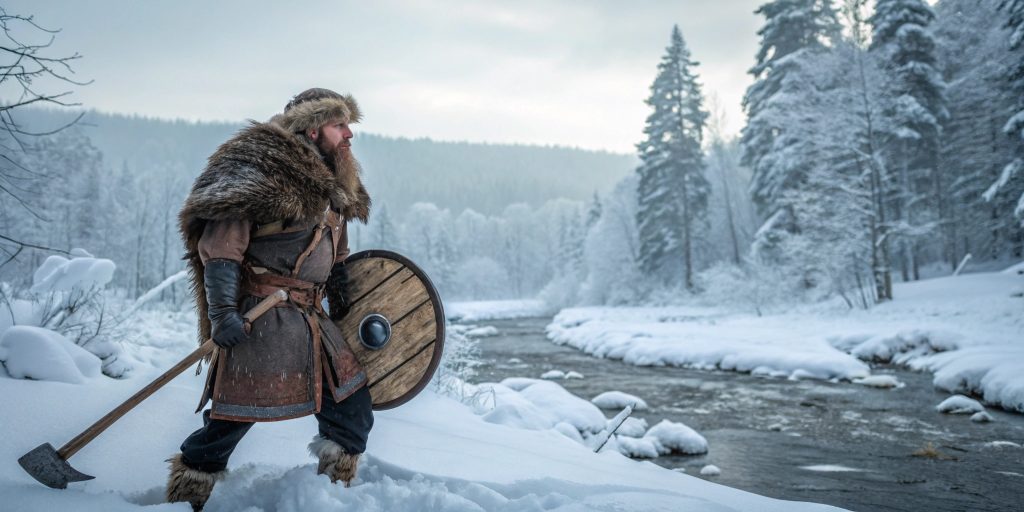Viking Clothing and Jewelry, Vikings
Did Vikings Wear Fur?
Wondering if Vikings wore fur is more than a simple question. It dives into their culture and daily life. Fur was key in their clothes, not just for warmth but also as a sign of status.
Exploring Viking clothing reveals how fur was tied to their social life. It also shows the role of fur in their culture and how it shaped their image.
Understanding Viking Clothing
The Viking wardrobe shows the practical needs and cultural values of the Norse people. Clothes were made for function, warmth, and style. They were for both men and women. This part looks at the parts of historical Viking clothing and the materials used in their daily clothes.
Overview of Viking Wardrobe
Viking clothing usually had:
- Tunics: Worn by both genders, often belted at the waist.
- Trousers: Common for men, providing comfort and mobility.
- Cloaks: Essential for warmth, these were often fastened with brooches.
This mix shows how Viking clothes were adaptable. They were practical in many environments.
Materials Used in Clothing
The choice of fabrics was vital for durability and comfort. Important materials were:
- Linen: Commonly used for inner layers, providing breathability.
- Woolen: Valued for its insulating properties, wool was ideal for colder weather during the Viking period.
- Animal skins: These were used for outerwear, offering protection against the elements of the Viking era.
Women in the Viking community often hand-wove these fabrics, making their clothes unique. The mix of materials helped Vikings cope with harsh climates, making their clothes practical and functional.
Historical Context of Viking Fashion
Many cultural interactions shaped Viking fashion. During the Viking era, Scandinavians traded and explored, meeting new societies. This led to a mix of styles that made Viking clothes practical and stylish.
Cultural Influences on Clothing Styles
Cultural influences changed Viking clothes a lot. Key interactions were:
- Trade routes connected Greenland, Europe, and Asia, sharing textiles and decorations.
- Conquests and settlements brought new styles to Scandinavian society.
- Christianity’s spread in the later Viking Age made clothes more modest.
These factors made Viking clothes rich and varied, reflecting the diverse Viking world. They showed both function and style, adapting to new cultures.
Adaptations Over Time
Viking fashion changed over time and was influenced by the environment and society. Important points were:
- Climate changes led to warmer clothes made from different materials.
- Wool became key in cold areas because of resource availability.
- New social norms and church influences changed fashion to reflect values.
These changes show how Vikings kept their identity while embracing new influences.
Did Vikings Wear Fur?
Fur garments were common in Viking clothing. They show us how Vikings lived and what they valued. Vikings used animal fur for both warmth and style.
Common Types of Fur Used
- Beaver: Its warmth and water resistance made beaver fur great for cloaks and hats.
- Fox: Soft and colorful fox fur was used in decorative items and clothes.
- Hare: Hare fur kept people warm, making it perfect for tunics and coats.
Purpose of Wearing Fur
Fur kept Vikings warm in cold climates, essential for their survival. It also showed who was wealthy and important.
Wearing expensive fur meant you had status. It showed you had the means to get such valuable materials. Fur was more than just clothing; it was a sign of who you were in Viking society.
The Role of Fur in Viking Society

Fur was key in Viking society, both for its use and symbolism. The cold climate of Scandinavia made fur a must for warmth. It kept people cozy and showed off wealth and status.
Status Symbols and Wealth Indicators
Fur clothes were more than just warm. They showed who was rich and important. The fancier the fur, the higher the status. Sable and fox furs were especially valued for their luxury.
Practical Uses in the Cold Climate
Fur was also crucial for survival in the cold. It kept Vikings warm and protected from the weather. They made clothes like Norse coats, cloaks, and hats from different furs, which Vikings took from various regions. This made fur essential for both style and survival.
Archaeological Evidence of Viking Fur Usage
Many discoveries show how Vikings used fur. Burial sites have uncovered important Viking artifacts, revealing what materials they used and their cultural meaning.
Key Discoveries and Artifacts
Scandinavia’s digs have found many fur garments. Places like Norway and Sweden show fur’s role in daily life and rituals. Tools for fur work and animal hides help us see the skill behind these items.
Analysis of Burial Sites and Clothing Remnants
Graves have given archaeologists vital clues about Viking clothing. Furs and other items in graves show a person’s status. Studying these helps us know which furs were used and their importance in Viking culture.
Types of Viking Fur Garments
The Vikings loved their practical and versatile clothes. Fur garments were vital in their daily wear. Fur cloaks and fur-lined tunics kept them warm and showed their culture.
Fur Cloaks
Fur cloaks were vital for Viking clothes. They were warm and comfy, perfect for the cold north. Made from top-quality pelts, they had fancy designs showing the wearer’s status.
These cloaks were a must-have for Viking warriors and explorers. They kept them safe from the weather and made a fashion statement.
Fur-Lined Tunics and Trousers
Fur-lined tunics and trousers were also favorites. They kept warm in cold winters. Wool fabrics with fur lining made them cozy and strong.
Old Viking tailoring was all about detailed stitching, which made the clothes fit well and look good. Fur-lined clothes were a big part of Viking life, fitting their needs and style.
Viking Women’s Clothing and Fur
Viking women were important in their society. Their clothes showed their role and status. Fur was vital in their outfits for warmth and meaning.
Fur was a big part of Viking style, showing who they were and the femininity of their clothes.
Fur in Women’s Garments

Fur was used in many women’s clothes. It was practical and looked good. Here are some examples:
- Cloaks kept them warm in cold weather
- Fur-lined tunics were stylish and useful
- Trousers with fur added comfort and style
These clothes were made with care. They used the best furs to show who they were.
Symbolism of Fur in Viking Women’s Fashion
Fur in Viking women’s fashion meant a lot. It showed their place in society and family. Fur clothes meant:
- They were wealthy, especially with rare furs highly valued in the Viking world.
- They were strong and beautiful, fitting their roles
- They were connected to their culture and traditions
Fur in their clothes was more than just for warmth. It lets them show who they are and their place in society.
Comparative Analysis of Viking Clothing Across Regions
Viking clothing varied by location, showing the effect of local culture and climate. Danish, Norwegian, and Swedish Vikings had their styles. These styles were not just practical but also showed their identity and status.
Understanding these differences helps us see the rich Viking culture. It has fascinated many for centuries.
Differences Between Danish, Norwegian, and Swedish Vikings
Danish Vikings liked clothes made from lighter materials. This was because their coastal area had a milder climate. Their clothes were tight and had lots of decorations like brooches and embroidery.
On the other hand, Norwegian Vikings wore thicker clothes for cold winters. They used wool and fur to stay warm. Layering was key to their outfits, especially in Iceland’s colder climates.
Swedish Vikings mixed Danish and Norwegian styles. They used local materials like flax, linen, and wool. Their patterns showed off their skills and what they had available.
These differences show how important location and culture were. Each group adapted to their area while sharing ideas through trade in the Viking world.

